Find out which fabrics and cloths work best for homemade face masks. The best fabric for DIY face masks is one that is both effective and comfortable!
After sharing our patterns for both the DIY fitted face masks you can sew, as well as easy no-sew face masks, we’ve been flooded with questions about making DIY face masks! One of the biggest questions we get is which fabric is best to use for these homemade face masks. The CDC recommends we wear multiple layers of fabric that can be laundered and machined dried, but also allows for breathing without restriction. In their instructions, they list “tightly woven cotton fabric” as well as a T-shirt or a bandana. But how well do these fabrics really work? And what if you don’t have cotton, T-shirts, or bandanas to use? We can help with all of these questions and gives you safe and effective ideas for the best fabric for face masks!
My Easiest DIY Face Mask With the Best and Most Effective Fabric:
Here’s a three-minute video that shows you how to make a simple face mask with the most effective fabric you can find at home:

And here is where you can get the free patterns to make this easy face mask:
In my research, I found that a typical surgical mask appears to have three layers made of various non-woven polypropylene materials: a breathable type of polypropylene for next to mouth, a microfiber filtering type of polypropylene in the middle, and a barrier type of polypropylene on the side facing out. You may find non-woven polypropylene in some reusable grocery bags, conference bags, or garment bags (you want the kind that feels like fabric or light canvas, not vinyl or plastic—it must be breathable but also water repellent). Alas, one does not typically find any quantities of polypropylene at the store, other than in pricey interfacing. So we must also look to other more easily obtainable fabrics to create an effective DIY face mask.
Cotton is a natural choice for a DIY face mask material for several reasons. First, cotton is porous, which makes it highly breathable. Also, cotton is absorbent, meaning it will pull the moisture out of the virus (which it needs to live). Plus, cotton is positively charged — this is good because viruses are negatively charged and will be attracted to the cotton molecule, rather than pass right through the mask into your mouth or out into the world. Finally, cotton is very easy to obtain, making it an excellent fabric for DIY face masks.
My vote for the best fabrics for face masks are two layers of cotton and a layer of non-woven polypropylene if you can find it.
But let’s go through all of the fabrics everyone has asked me about so far so we can discuss them in more detail!
Important Note: As my research continues into face mask fabrics, I will update this list to help you make the most informed decision for your DIY face mask making efforts. It’s critical to note that a fabric’s inclusion on this page does NOT make it suitable. Be sure to read the notes!
Looking for my DIY face mask tutorial? You’ll find it here!
Non-Woven Polypropylene (NWPP) Material
Polypropylene is what surgical face masks are from, but you’ll also find it in reusable store bags and interfacing. Polypropylene is generally quite good at repelling viruses because it provides water resistance for blocking droplet transmission and mechanical filtration from the structure of the fibers. If you could get some melt-blown non-woven polypropylene, this would be an ideal choice for one of your layers.
Availability: You can typically find non-woven polypropylene materials in any of your reusable totes from stores.
Effectiveness: Simple respiratory protection–evaluation of the filtration performance of cloth masks and common fabric materials against 20-1000 nm size particles (October 2010)
Fabric Breathability: Good
Close-Up of Fabric: Note that while non-woven polypropylene looks as if it is woven with the naked eye, it’s just the way it is “blown” — you can see in the electron microscope image that it is most definitely NOT woven and it is just a maze of fibers that can trap a virus.
Tightly Woven Cotton (aka “Quilting Fabric”)
The CDC’s sewn cloth face covering material list calls for “tightly woven cotton, such as quilting fabric or cotton sheets.” Recently, Wake Forest Institute for Regenerative Medicine tested a range of fabrics in 400 DIY masks and found that two layers of high-quality, heavyweight “quilter’s cotton” with a thread count of 180 or more, and “those with especially tight weave and thicker thread, such as batiks,” were the best performing. Most cotton fabric you’ll find at the fabric store is between 120-160 thread count (I counted myself). The higher the thread count, the tighter the weave, so for the highest thread count you can find. Also of note: cotton is absorbent, and that can pull the moisture out of any trapped virus particles in the mask, causing them to die faster (virus particles need moisture to live).
Availability: You can typically find cotton fabric at fabric stores, as well as in your own linen closet in high-thread count sheets.
Effectiveness: Tightly woven cotton is effective at removing .3-1.0 micron particles, according to Wake Forest Health’s recent research
Fabric Breathability: Excellent. Multiple layers of 100% cotton fabric, even the super densely woven type, is quite breathable. This is my #1 choice for DIY face masks.
Close-Up of Fabric:
Tip: How to Figure Out the Thread Count of Cotton
Thread count is simply the number of threads across and down in a 1 inch square of fabric. The way I count is to cut a one-inch piece of fabric, take a photo of it on 2x magnification with my phone, then view it and zoom in as necessary to count the threads. This is a bit time consuming, of course, but it gives you an accurate count. Here is a photograph of 1 inch square of fabric where I’ve counted the threads across (warp) and the threads down (weft), then added them together — which tells me this quilting cotton is 129 thread count.
Note: If you don’t have time to count threads and just want to see if a fabric seems tightly woven enough, hold it up to the light to see how much light you can see between the threads. The less light you see between threads, the higher the thread count.
T-Shirts
100% heavyweight cotton T-shirts are both comfortable and pretty effective, in a pinch. The heavier the shirt the better. Lightweight shirts won’t offer much. And cotton is better than polyester because it is absorbent, and that helps pull moisture out of particles that may contain viruses. T-shirt knit fabric is very elastic, comfortable, lightweight, breathable, and can be washed and worn many times. The biggest downside is that it’s not as tightly woven as quilting cotton.
Availability: You can find cotton T-shirts in many big box stores, as well as in your own clothes closet
Effectiveness: Testing the Efficacy of Homemade Masks (Cambridge University, 2013)
Fabric Breathability: Excellent. Multiple layers of 100% cotton T-shirt fabric is very breathable. If you’re looking for comfort, this is it.
Bandanas
Most bandanas are made from a very lightweight and NOT tightly woven fabric, making them far from the best fabric for DIY face masks. However, any mask is better than no mask if this is all you have. Use as many layers as you can tolerate if you use a bandana.
Availability: You can find bandanas in many big box stores.
Effectiveness: No research found yet
Fabric Breathability: Excellent. Multiple layers of bandana fabric is very breathable, but that’s also because they are not tightly woven.
Flannel
Flannel has a pile fabric structure and, because of that, is effective at trapping viruses. You want 100% cotton flannel if possible.
Availability: You can typically find flannel fabric at fabric stores—or try an old flannel sheet or flannel shirt.
Effectiveness: Good when paired with 100% cotton according to Wake Forest Health’s recent research
Fabric Breathability: Ok. Flannel can cause more condensation and be a little harder to breathe through.
GORE-TEX
GORE-TEX is a lightweight, microporous material used for outdoor clothing. A number of people wondered if it might be a good material, but the company released a statement warning against this material because it does not “provide sufficient airflow to support human respiration.”
Availability: You can typically find Gore-Text fabric in outerwear, like parkas and raincoats.
Effectiveness: No research found yet
Fabric Breathability: Poor. Do Not Use.
Cotton Towels
100% cotton towels can provide some protection, however, they aren’t the most comfortable thing to wear.
Availability: You can find towels in many big box stores or your linen closet.
Effectiveness: The Annals of Occupational Hygiene, Volume 54, Issue 7, October 2010, Pages 789–798
Fabric Breathability: So so — they are quick thick, so not as good as cotton quilting fabric
Sweatshirts
Ok, so what about a sweatshirt? 2010 research found that an 70% cotton/15% polyester Hanes sweatshirt provide “marginal protection against nanoparticles including those in the size ranges of virus-containing particles.” Generally speaking, the higher the cotton content, the better.
Availability: You can find cotton sweatshirts in many big box stores, as well as in your own clothes closet
Effectiveness: The Annals of Occupational Hygiene, Volume 54, Issue 7, October 2010, Pages 789–798
Fabric Breathability: Not as good as other options due to its thickness, plus it’s hotter to wear
Underwear
I had to add this to the list after seeing a video of a woman attempting to make a mask from ladies underwear (I kid you not). Unfortunately, I don’t feel underwear, even if it’s 100% cotton, will offer a lot of protection. Underwear is, by it’s very nature, a lightweight fabric and it’s very unlikely to be tightly woven enough to be very effective. It’s funny, but not functional, as a face mask fabric.
Availability: You can find cotton underwear in many big box stores, as well as in your own clothes closet
Effectiveness: No research found yet
Fabric Breathability: Highly breathable because it’s not closely woven. Do Not Use.
Interfacing
Interfacing is normally used to stabilize fabrics when cutting and sewing. “Non-woven” interfacing is usually polypropylene. Interfacing is more typically used as a filter material. Multiple layers of interfacing would be hard to breathe through, making it a poor option for face mask material.
Availability: You can find interfacing at fabric stores, some craft stores, and online, specifically Pellon interfacing 380, 808, 810, 830, 880F, 910, 911FF, 930, 931TD, 950F, and Oly-Fun by Fairfield.
Filter Effectiveness Research: None. Currently, I can find no published scientific research that supports interfacing effectiveness.
Filter Breathability: Ok to poor. Interfacing can be hard to breath through. The Pellon 808 I tried seemed tolerable, but perhaps not for long periods of time.
Microfiber
Microfiber fabrics, typically made of polyester, can be effective because they can trap the virus particle in their dense thicket of fibers. They are also water repellent, which is good for more humid climates or sweaty faces. Look for soft woven microfibers, like those found in sheets and shower curtains (don’t get vinyl). Look for 90 gsm or higher.
Availability: You can find microfiber sheets and shower curtains in many big box stores, as well as in your own linen closet
Effectiveness: The “Tea Towel” and possibly the pillowcase may have been microfiber in this study: Testing the Efficacy of Homemade Masks (Cambridge University, 2013)
Fabric Breathability: Good
What about good face mask filter materials?
Check out my DIY Face Mask Filter Materials list for ideas!
For my personal DIY face masks, I’m sticking with multiple layers of 100% cotton with simple coffee filters until I see compelling scientific evidence on the effectiveness and safety of another face mask material. When and if I find that, I will update this page.
Get my free pattern to make your own DIY face mask!
Are you making fabric face masks? We’d love to see them and hear about the fabric you chose to use (and why)! Please post over in our Facebook group — everyone is welcome! Please share them in the group or email us at [email protected].
Love,

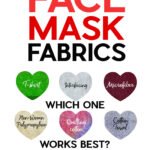
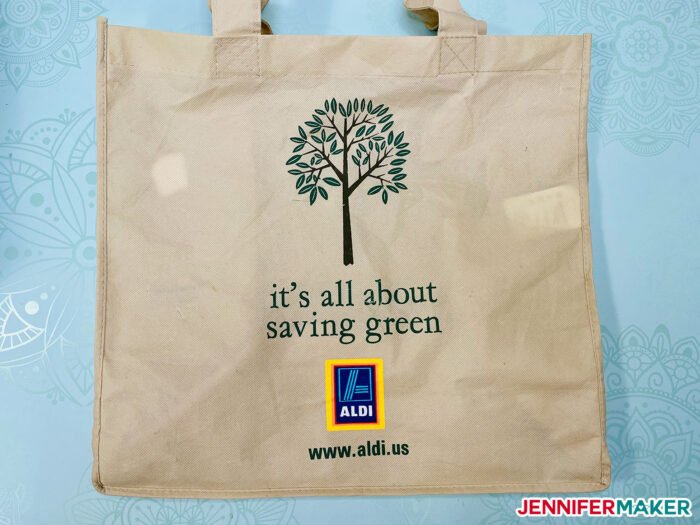
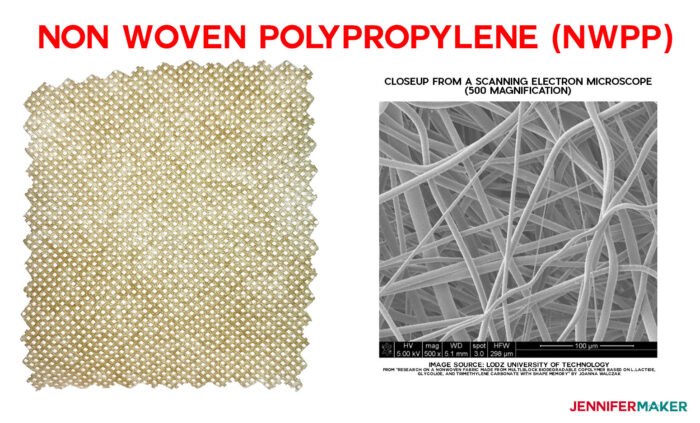
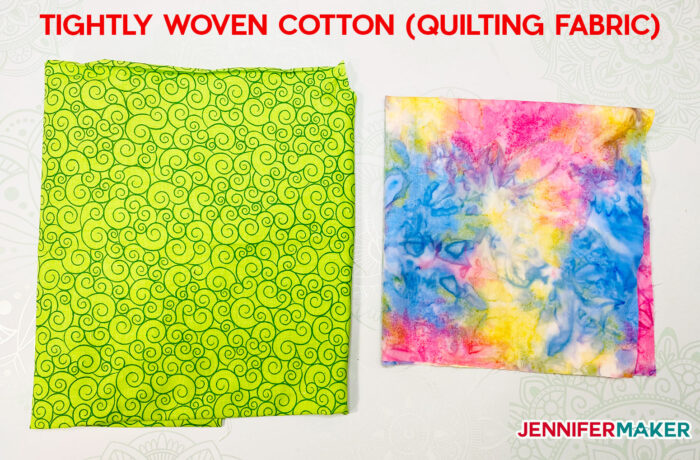

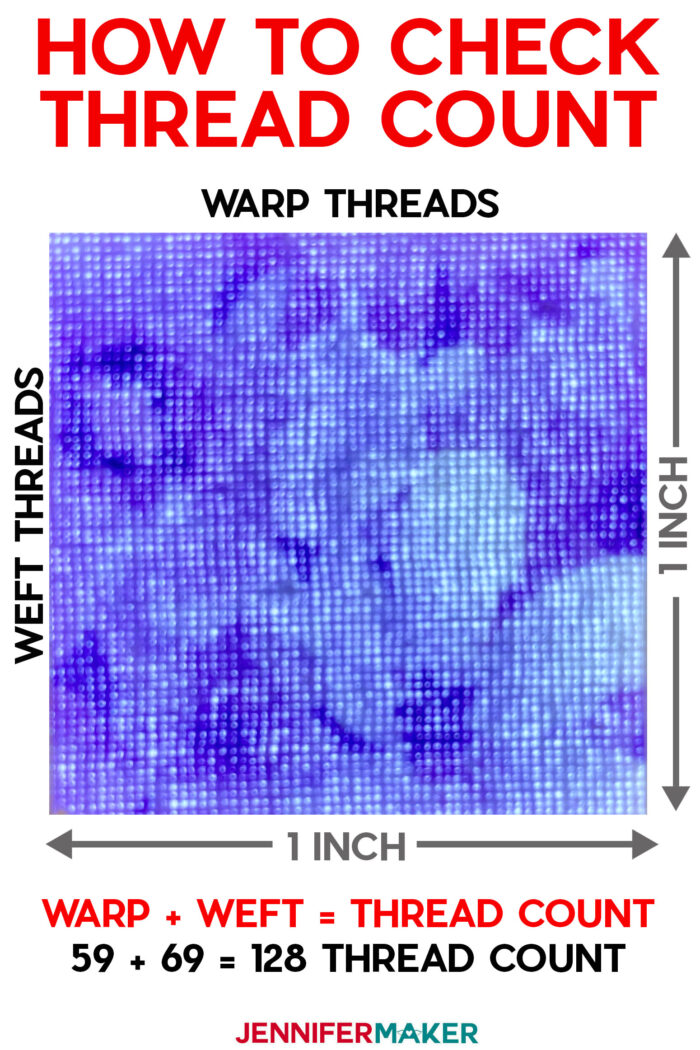
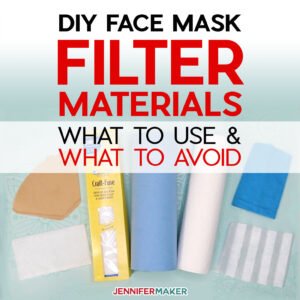

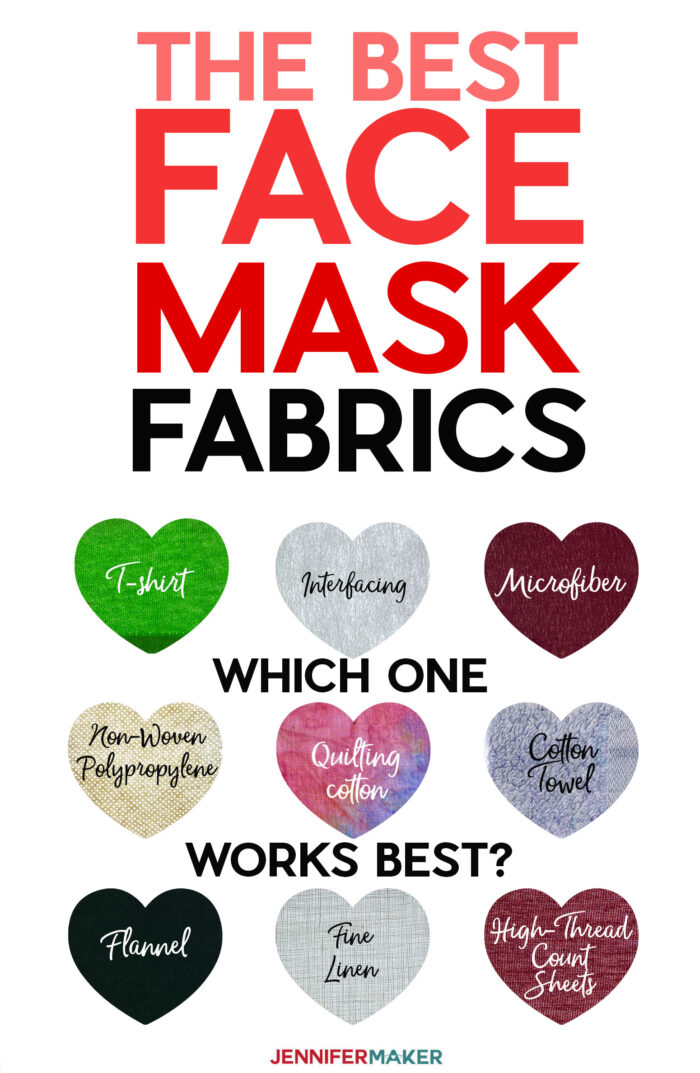





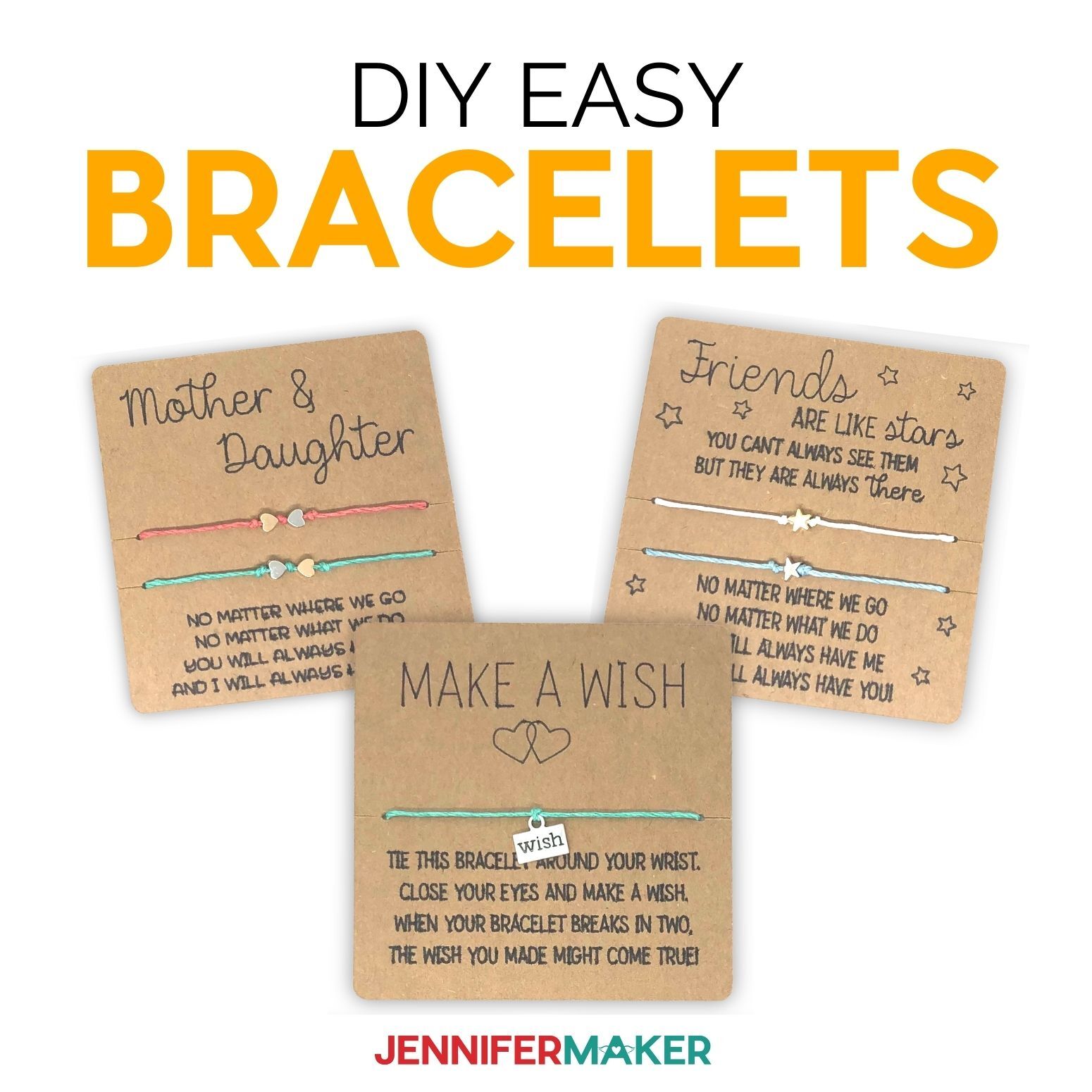
Thank you so much for all this detailed research you so generously share with all of us,you are an angel!
Thank you for sharing all your ideas and trick of this trade. It makes it very easy and fun to work with my cricut; instead of wasting so much time searching around. You make it easy making it a one spot stop for me. you are an angel for me too.
Thank you, Pam!
As a Dental Hygienist of 35+ years, I really appreciate the thoroughness of thoroughness research!
Thank you, Jennifer Maker!
I reference this document in other groups I belong to – Thank you for doing the research and placing it in one document. Sadly, in the rush/panic to get product out, whether for compassionate or for profit reasons, people are doing so many alterations and additions of wierd/unconventional products, to the masks they are making, with very little thought or actual research as to their suitability, safety and comfortable wearabilty for the end user.. I forsee many such masks getting quickly discarded or sitting unused. A waste of time, material and money for the maker.
I used your pattern than found 3M Filtrete filters at Walmart that I cut out of plastic housing, took off the glue that connected them accordion style, ironed out (using press cloth) than cut to size. These filters supposedly are 99.97% at keeping everything out. I’ve made 140 masks that I’ve given to co-workers at my hospital. They LOVE them. Donating 30 of those to our Cancer center tomorrow. Thank you SO MUCH for the pattern.
This is brilliant Jennifer. what a lot of work you have put into this and it is extremely informative.THANK YOU!
Thank you so much for all this information and the free pattern. It is very sweet and kind of you.
You’re welcome, Tricia!
great information…thanks.
Great information! Thank you for all your research. I blew it on the interfacing ☹️I used Pellon #805. Love your site👍🏽😷😷😷😷😷😷😷
Early in this post, you mentioned ideally you would recommend using 2 layers of cotton and 1 layer of non-woven polypropelene in making a mask. Would the NWPP be best used as the outermost layer, or as the inner layer between the cottons?
In my research, I didn’t see anything specifically answering your question. However, you might want to have the NWPP as the outer layer to prevent water droplets from coming into contact with the cotton. However, if you want to use it as a filter that you can remove when washing or replace, then you’d want to create a pocket and put it in the middle of your cotton fabric.
Do the edges of no-sew mask get fuzzy and a bit raveled after a few washings?
Hi Nancy! It really depends on what material you use. You could always use some washable fabric glue to glue down the edges to prevent fraying.